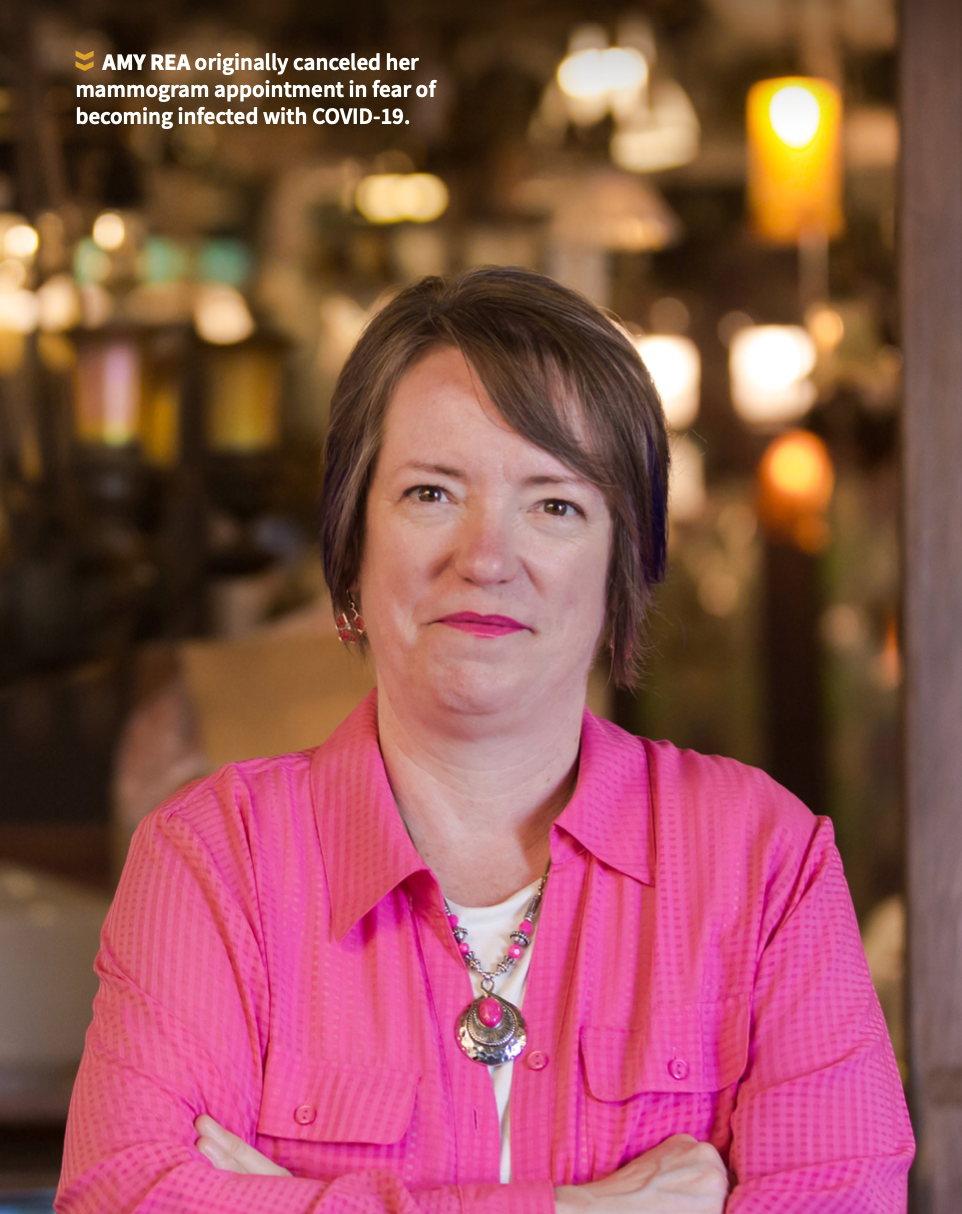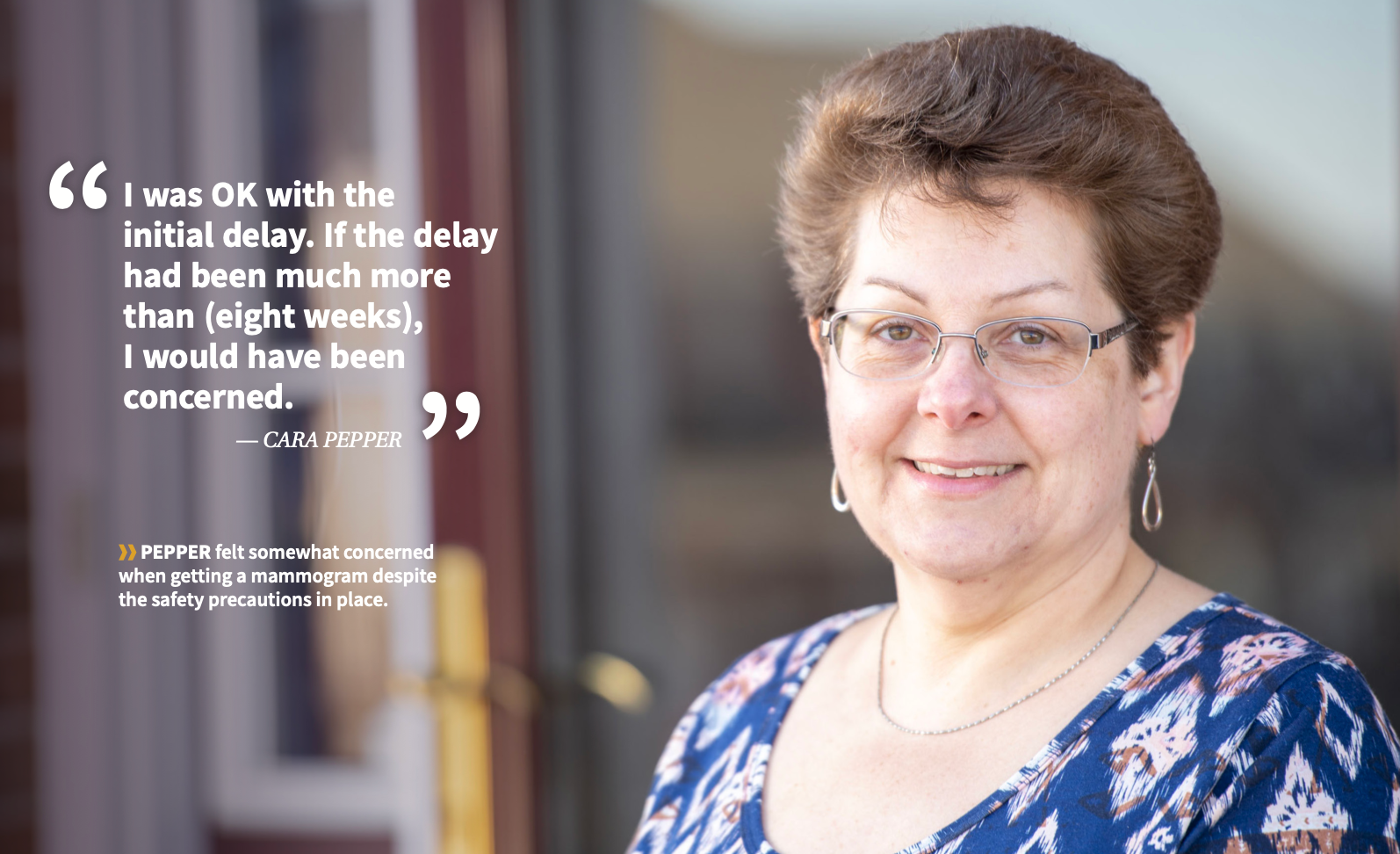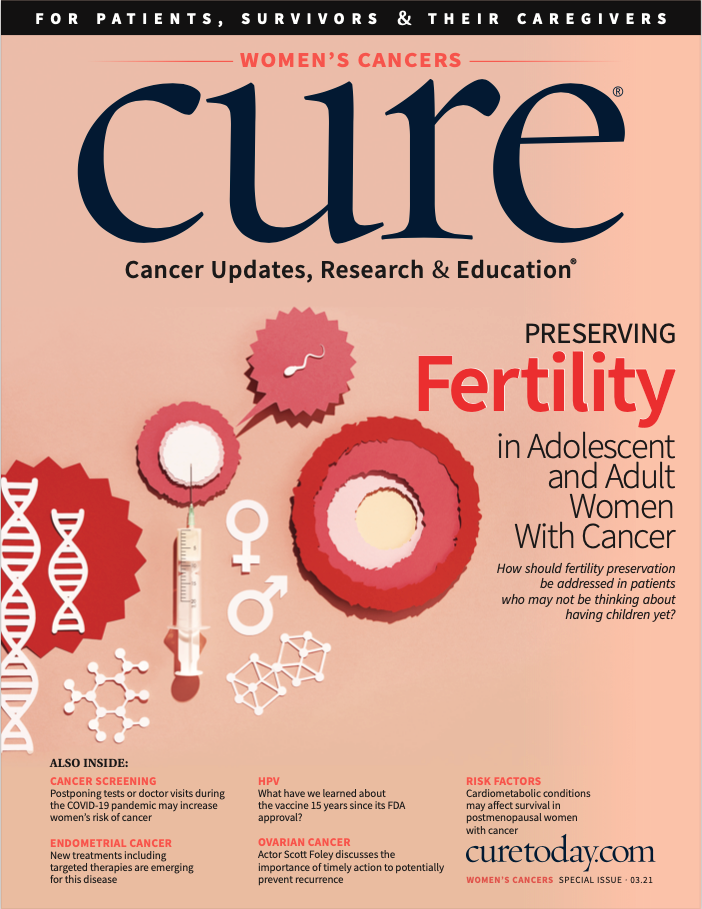Publication
Article
CURE
Is Delaying Cancer Screening Due to COVID-19 Fears Worth the Risk?
Author(s):
Postponing tests or doctor visits during the pandemic may increase women’s risk of cancer.
Amy Rea, 58, of Eden Prairie, Minnesota, has always been diligent about attending health care screenings. But last October, she had a decision to make — cancel the scheduled appointment for her annual mammogram or keep it and face potential exposure to the virus that causes COVID-19.
She canceled the appointment.
“There’s no family history of breast cancer, and every mammogram I’ve had has been fine,” Rea says. “I thought about it and decided it’s too close contact. Your face is in somebody else’s face, so I opted to postpone.”

Rea isn’t the only woman who has delayed cancer screening during the pandemic. Preventive screenings for all cancers, including breast and cervical, dropped in March and April 2020 as health care facilities halted all nonessential services including screening mammograms, and then restarted with modifications after the first wave passed. With protocols in place and a better understanding of risk, many women now feel comfortable going ahead with screenings. But for others, potential exposure to the virus that causes COVID-19 is too big a chance to take.
“During the first few months, we saw a cessation of all cancer screenings and all elective surgeries,” says Dr. Melissa K. Frey, assistant professor of obstetrics and gynecology in the Division of Gynecologic Oncology at Weill Cornell Medicine in New York City. “It’s undeniable that happened. But even today, we still see women delaying their screenings because they’re concerned about exposure to the virus.”
According to results from a study published by Epic Health Research Network, preventive screenings for breast and cervical cancer dropped by 94% when COVID-19 was first declared a national emergency. The organization later reported that between March 15 and June 16, 2020, approximately 285,000 breast exams and 40,000 cervical exams were missed. This is a drop of 63% in breast cancer screenings and 67% in cervical cancer screenings from the number expected based on historical averages.
Those missed screenings are concerning, according to Dr. S. Diane Yamada, chief of gynecologic oncology at University of Chicago Medicine and president-elect of the Society of Gynecologic Oncology. Her health care system saw a 17% drop in Pap tests in 2020 compared with 2019 numbers, she says, adding that between March and May 2020, mammograms were down 80% from their typical levels.
“Screenings are an opportunity to catch cancers early,” Yamada says. “I’m worried about cancer being diagnosed at later stages with poorer prognoses.”
With safety protocols in place, screening appointments at many facilities are on the rise. Still, experts can only speculate on the long-term impact of missed screenings during the initial pause and how it may affect women who continue to put off screenings because of fear of virus exposure. An article in a recent edition of Science stated that modeling the effect of COVID-19 on cancer screening and treatment suggests there could be almost 10,000 additional deaths during the next decade from breast and colorectal cancer.
The Importance of Cancer Screenings
Screenings can help doctors find cancer early, sometimes before symptoms appear. The American Cancer Society recommends annual mammograms for women ages 45 to 54, with women age 55 and older continuing annual mammograms or switching to a mammogram every two years. In addition, the American Cancer Society states that most women who get breast cancer do not have a family history of breast cancer, so it is important to undergo screening in the presence and absence of family history.
Cervical cancer screenings, also known as Pap tests or Pap smears, should be done every 3 years, starting at age 21, according to the American College of Obstetricians and Gynecologists. Experts also recommend testing for HPV every five years, starting at age 30. Annual OB-GYN visits are recommended for all women.
Studies have shown that screening lowers death rates for many of the common cancers, although there is ongoing debate about the extent of mortality reductions for different malignancies. Newer technologies have improved precision and reduced “false alarms.”
It’s easy to lose sight of the importance of screenings during a pandemic, Frey says. But delaying appointments has led to some patients presenting with more advanced disease.
Dr. Linda Donegan, director of breast imaging at Rhode Island Medical Imaging and assistant professor in the Department of Diagnostic Imaging at Brown University’s Warren Alpert Medical School in Providence, says that during the pandemic some patients opted to delay appointments for additional imaging even though screening mammograms showed suspicious areas.
“Imaging allows us to detect cancers when they’re smaller and at earlier stages, when they’re most treatable,” she says. “We have seen some cancers that have increased in size.”
Donegan says she understands women’s concerns about potential virus exposure. “We screen an older patient population, and we’re all being bombarded with bad news about COVID-19,” she says. “There’s a lot of anxiety and fear of the unknown.”
Rhode Island Medical Imaging has focused on letting patients know it’s safe to come in for screenings.
“We’re all patients at some point,” Donegan says. “And education is power. The more our patients know about the importance of screenings and the safety protocols we have in place, the more comfortable they’ll feel. This might be our normal for quite a while.”
Protecting Patients
Health care facilities have a variety of protocols to keep patients and staff at minimal risk of viral transmission. Masking, social distancing, hand sanitizing and enhanced cleaning measures between patient visits are now the norm in offices. Prescreening is also a critical part of safety, with many facilities requiring patients to self-screen for symptoms and answer questions about travel and potential virus exposure. Some have implemented patient temperature checks upon arrival.
Rhode Island Medical Imaging texts all patients 90 minutes before their appointment time with a link to an online COVID-19 screening tool. Patients call when they arrive, wait in their car until their appointment time and are brought right into the changing area.
Yamada says University of Chicago Medicine has tried to reduce additional barriers that might prevent people from coming to the office. “We’ve offered mammograms on weekends and after hours,” she says. “At one point, we were also allowing walk-in appointments.”
Frey says Weill Cornell is using telehealth for patient discussions when possible, keeping in-person appointments for screenings and physical exams.
“We’ve been relying on video visits where we can talk through issues and plans,” she says. Still, the pandemic has created new barriers to care for some people, such as finding safe transportation to appointments or using technology to access care.
“Many of our patients are 65 and older,” Frey says. “Technology is really intimidating for some people.”
Frey also notes that COVID-19 has amplified health disparities that existed before the pandemic began. According to a 2018 article in Health Equity, the incidence of cervical cancer is typically higher in Black and Hispanic women than in White women. A decrease in cancer screenings during the pandemic could lead to cancers being missed or diagnosed at more advanced stages in these populations.
“We know that there were disparities in cancer screening rates based on race, ethnicity, education level, insurance status and income level,” Frey says, adding that missed opportunities to diagnose cancer through screenings can lead to disparities in health outcomes. “Underserved populations have been hit hardest by COVID-19.”
Evaluating Risk
To date, no clear data exist on the risk of COVID-19 infection during a mammogram or cervical cancer screening visit. Ultimately, women must weigh the risk of potential virus exposure against their health history and make their own decisions.
Rea says she has tried to be strategic about avoiding risk. When she saw her primary care doctor this summer, she requested the first appointment on a Monday morning. “They had staff stationed at the front door doing temperature checks,” she says. “All staff members were wearing masks and visors, 6-foot spacing was clearly marked and they’d removed some of the seating from the lobby.”
Rea spoke with her doctor about the potential implications of delaying cancer screenings. Because she’s at higher risk for skin cancer, she chose to keep her scheduled dermatologist appointment. She also kept her annual gynecologist appointment for a pelvic exam and Pap smear test in October.
“My gynecologist was masked and wearing a visor,” Rea says. “I felt safe.”
Cara Pepper, 51, of Reading, Pennsylvania, says that although her scheduled mammogram and Pap smear test were initially delayed by her health care facility at the beginning of the pandemic, both appointments were rescheduled — and she kept them.

Pepper, who works for a health care system, says she wasn’t concerned about virus exposure during her screenings.
She says she’s familiar with the protocols and procedures the hospital uses and, as a patient, those protocols helped her feel safe at her appointments. “I was really fine with it,” she says.
Still, she admits she felt a “slight” concern about getting a mammogram.
“You do have to get extremely close to the technician while they’re manipulating your breast into the machine,” she says. “I just looked the opposite way when we were close.”
Pepper’s original appointments were delayed by about eight weeks at the pandemic’s start.
“I was OK with the initial delay,” she says, adding that, although she isn’t considered high risk, there is a history of multiple types of cancer in her family. “If the delay had been much more than that, I would have been concerned.”
Protecting Your Health
Doctors want women to know that if they choose to delay screening, it’s important to get in touch if they experience new or troubling symptoms. “I had one patient with an enormous ovarian mass who delayed an appointment because of (COVID-19) fears,” Yamada says. “It got to the point where she couldn’t walk anymore and her family finally had to bring her in.”
Women who are at higher risk of breast, cervical, uterine or ovarian cancer should arm themselves with knowledge of potential signs and symptoms, Yamada says. If a woman with symptoms is afraid to come in, she should reach out to her doctor or a nurse triage line right away, she adds. “We can’t necessarily examine a patient during a telehealth visit, but we can talk about symptoms and decide if you must be seen,” Yamada says.
Bleeding after menopause is one symptom that should be evaluated immediately, according to Frey. She also advises women to contact their doctor if they experience bleeding after intercourse, abdominal pain or pain when urinating.
Donegan encourages patients at higher risk of cancer to talk to their doctor about the risks of delaying screening. Patients also can call the facility to talk about safety protocols that have been put in place.
“We’ve had patients who are fearful and anxious,” she says. “We’re happy to walk them through our process.”
Rea says she hasn’t yet rescheduled her mammogram, but she expects to soon.
“If there had been a family history of breast cancer, I absolutely would have gone,” she says.
For more news on cancer updates, research and education, don’t forget to subscribe to CURE®’s newsletters here.





